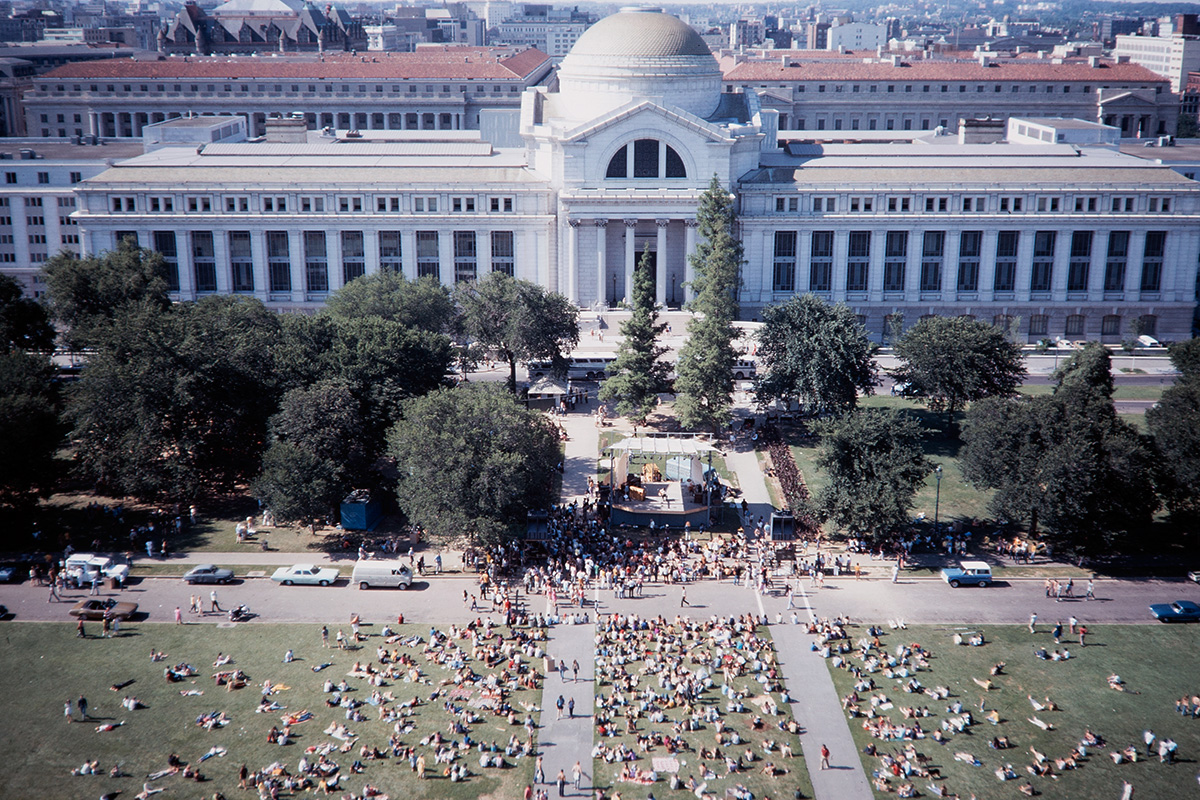The Folklife Family Tree

Fifty years ago, the roots of the Smithsonian Folklife Festival were planted on the National Mall, featuring traditions of people from around the United States and the world. At the first Festival, banjo-pickers and ballad singers performed alongside Navajo sand painters and basket and rug weavers, to the delight of thousands of visitors. This four-day event in July 1967 started a yearly tradition, answering the call from former Smithsonian Secretary S. Dillon Ripley to “take the instruments out of their cases and let them sing.”
On July 8 and 9, 2017, a series of discussion sessions took place as part of the Festival’s 50th Anniversary Reunion Weekend. As a fall intern, I was assigned to transcribe the sixteen discussion sessions and a series of oral interviews, naïve to the foundational roots of the Festival. What I’m beginning to learn is that its roots run deep in Washington, D.C., and at this institution. Once the roots burrow into you, they plant seeds of inspiration that will germinate and grow.
After listening to the Reunion Weekend sessions, I’ve found that the metaphor of “roots” permeates all aspects of the discussions as well as the oral histories. I imagine these roots as Festival staff spreading outward from a core tree trunk, established by founding director Ralph Rinzler, to provide strength, endurance, and longevity. The purpose of the weekend was not only to reminisce on the past fifty years, but to turn the discussion toward the future of the event.

“Ralph was always looking for root traditions, the origin of that tradition,” Jeffrey LaRiche, former program coordinator, stated in the session entitled “The Vision and Legacy of Ralph Rinzler.” “I think that legacy is still seen in the Festival today.”
The metaphor of the family tree was strongly emphasized during the penultimate session, “From Research to Realization.” In the early years of the Festival, Ralph worked with eminent scholar and activist Roy Bryce-LaPorte. His daughter, Camila Bryce-LaPorte, has worked with the Center off and on since the late 1980s, most recently producing a Caribbean music segment for the 2017 On the Move program. Camila’s teenage son, Michael, was a participant in the 2013 Will to Adorn program and On the Move.
The family tree isn’t limited to Festival staff. Participants have set down roots at some of the earliest events and are watching them spread throughout years of Festival programs. At the Reunion Week’s oral history interview sessions, Pam Henson, director of the Institutional History Division at Smithsonian, interviewed not only staff but visitors and participants too.

Participant Sheryl Sturges told Pam, herself a long-time staff member and branch of the Festival tree, the story of her grandfather’s first cousin, Arthur Sayler. Arthur and his family participated in the 1991 Festival to demonstrate lime stone fence post carving at the Family Farming in the Heartland program. Fast forward to 2017, and Sheryl’s daughter, Sara Deull, performed trapeze acts in Circus Arts.
“It’s an unusual genealogy,” Sheryl said. “There are strong people in Kansas that can do anything, and you never know from what roots the direction in which you will go.”
This was just one of a handful of family seedlings from the Reunion Weekend activities, and Sheryl said she looks forwards to cheering on her grandson in his pursuit of juggling and trapeze arts. Maybe he, too, will one day land at a future Folklife Festival.
Intergenerational narratives can also be found in stories passed from the roots of the Festival to the new branches continuing the legacy and tradition. Amalia Cordova, the Center’s newest curator, explained in the “Boldly into the Future, Some New Voices” discussion session: “I’ve heard the lore from previous Festivals, and it helps me navigate and plan future Festivals.”
When the next generation of Festival staff and volunteers arrive, they too will receive the lore and become part of the family. People and programs that land, germinate, and grow are welcomed onto the National Mall and into the family so deeply that “there will always be a place for everyone to belong,” said Angelica Aboulhosn, former public affairs specialist.

While I learned a great deal about the history and future of the Festival from transcribing the 50th anniversary discussions and interviews, I have also seen the “family dynamics” play out in real time. The weekend of October 14 and 15, 2017, the Festival co-presented IlluminAsia, the reopening event for the Smithsonian’s Freer | Sackler Galleries. Everyone at the Center, including myself and other interns, jumped in to help with pre-event logistics, crowd control, and assisting participants with navigating the event site, ensuring a successful time for all involved. Just like at a family reunion or at a Folklife Festival, Center staff came together to help out and foster a successful, engaging event.
Looking into my own future, no matter where I go over the next few years while pursuing more education, I fully expect to return to the Center to continue to serve as a volunteer at the Festival. I know I will be welcomed back into the family to further strengthen the programs—and to continue to pass the lore onward.
Taraya Middleton is an intern at the Center for Folklife and Cultural Heritage, finishing her post-baccalaureate practicum in heritage resource management. She is from Alberta, Canada.

